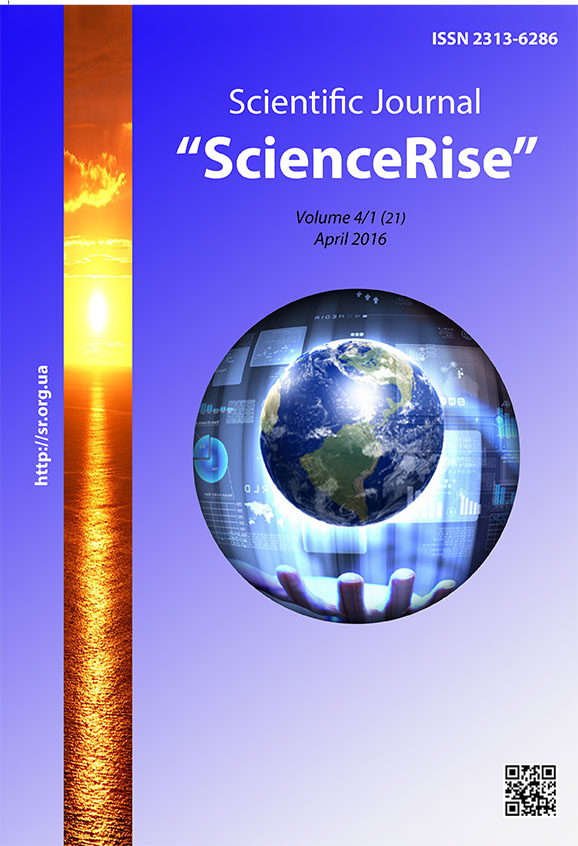Аналіз еколого-географічних особливостей центрів походження Triticum spelta і перспективи поширення культури в Україні
DOI:
https://doi.org/10.15587/2313-8416.2016.66199Ключові слова:
спельта, ГІС, моделювання, біокліматичні показники, центри походження, Triticum spelta, гліадиниАнотація
Вивчення особливостей еколого-географічних центрів походження Triticum spelta вказують на високу екологічну пластичність «дикороса альпійських прерій». Лімітуючими факторами, які визначають можливість рослини рости, розвиватися, розмножуватися та проявляти бажані господарські якості в Україні є максимальна температура самого теплого місяця та показники pH ґрунту
Посилання
Flyaksberher, K. A. (1935). Wheat. Vol. 1. Moscow; Leningrad: Gos. Publishing House kolhoznoy and sovhoznoy lit-ry, 262.
Zhukovski, P. М. (1971). Cultural plants and their relatives. Leningrad: Kolos, 448.
Kuckuck, H., Schiemann, E. (1957). Über das Vorkommen von Spelt und Emmer (Triticum spelta L. und T. dicoccum Schübl.) im Iran. Z. Pflanzenzüchtung, 38, 3833–3896.
Kihara, H., Yamashita, K., Tanaka, M. (1965). Morphological, physiological, genetical and cytogenetical studies in Aegilops and Triticum collected from Pakistan, Afghanistan and Iran. Results Kyoto Univ. Sci. Exp., 1, 1–118.
Mustafaev, I. D. (1964). Wheats of Azerbaijan and their value are in a selection and process of formation of forms. Bobrovsk: VNIIS.
Veremeychyk, A., Pashkevich, G. (2004). Peculiarity of ancient settlement in the tract Ovramenko circle. Archaeological research of L’viv University, 7, 270–281.
Romanova, Y. A., Gubareva, N. K., Konarev, А. В. (2001). Research of collection of type of wheat of Triticum spelta on polymorphism of gladin. Geneticist, 37 (9), 1258–1265.
Blatter, R. H. E., Jacomet, S., Schlumbaum, A. (2004). About the origin of European spelt ( Triticum spelta L.): allelic differentiation of the HMW Glutenin B1-1 and A1-2 subunit genes. TAG Theoretical and Applied Genetics, 108 (2), 360–367. doi: 10.1007/s00122-003-1441-7
Species. Global Biodiversity Information Facility. Available at: http://www.gbif.org/species
Data for current conditions (1950–2000). WorldClim – Global Climate Data. Available at: http://www.worldclim.org/current
McFadden, E. S., Sears, E. R. (1946). The origin of Triticum spelta and its free-thresching hexaploid relatives. Jounal of Heredity, 37, 107–116. Available at: http://www.oxfordjournals.org/our_journals/jhered/freepdf/37-107.pdf
Karpun, Y. (2004). Fundamentals yntroduktsyy plants. Hortus botanicus, 2, 17–32. doi: 10.15393/j4.art.2003.168
Characteristics of agricultural land by the reaction of soil solution on the results of 9 agrochemical certification round (2006–2010). Institute of soil conservation Ukraine. Available at: http://www.iogu.gov.ua/pasportizaciya/karty-po-vmistu-pozhyvnyh-rechovyn-rn-humus-fosfor-kalij/
##submission.downloads##
Опубліковано
Номер
Розділ
Ліцензія
Авторське право (c) 2016 Віталій Васильович Лапчинський

Ця робота ліцензується відповідно до Creative Commons Attribution 4.0 International License.
Наше видання використовує положення про авторські права Creative Commons CC BY для журналів відкритого доступу.
Автори, які публікуються у цьому журналі, погоджуються з наступними умовами:
1. Автори залишають за собою право на авторство своєї роботи та передають журналу право першої публікації цієї роботи на умовах ліцензії Creative Commons CC BY, котра дозволяє іншим особам вільно розповсюджувати опубліковану роботу з обов'язковим посиланням на авторів оригінальної роботи та першу публікацію роботи у цьому журналі.
2. Автори мають право укладати самостійні додаткові угоди щодо неексклюзивного розповсюдження роботи у тому вигляді, в якому вона була опублікована цим журналом (наприклад, розміщувати роботу в електронному сховищі установи або публікувати у складі монографії), за умови збереження посилання на першу публікацію роботи у цьому журналі.

